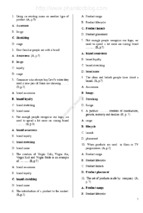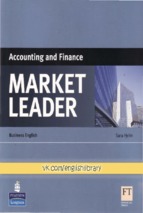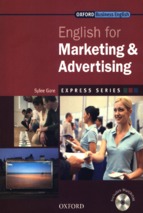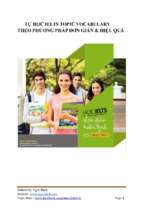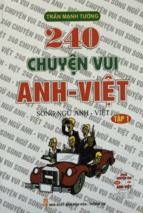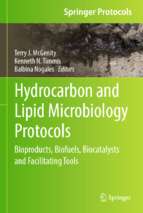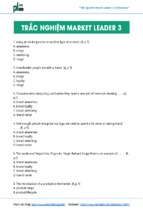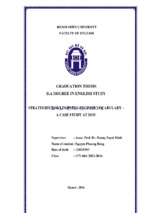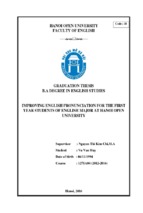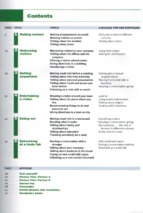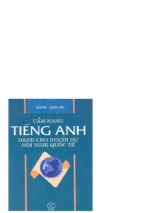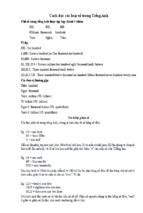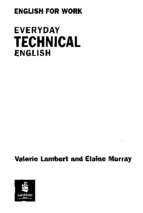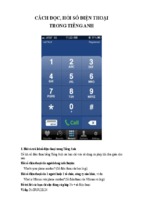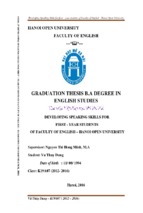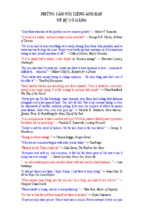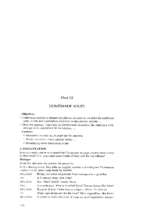HỌC VIỆN CÔNG NGHỆ BƯU CHÍNH VIỄN THÔNG
TIẾNG ANH
CHUYÊN NGÀNH QTKD
Lưu hành nội bộ
HÀ NỘI
Thuvientailieu.net.vn
HỌC VIỆN CÔNG NGHỆ BƯU CHÍNH VIỄN THÔNG
TIẾNG ANH
CHUYÊN NGÀNH QTKD
Biên soạn :
THS. PHẠM THỊ NGUYÊN THƯ
THS. NGUYỄN THỊ THIẾT
Thuvientailieu.net.vn
Unit 1: Economic activity
UNIT 1. ECONOMIC ACTIVITY
I. INTRODUCTION
Bạn bắt đầu học bài đầu tiên của phần tiếng Anh chuyên ngành Quản trị kinh doanh. Bài
được bố cục theo trình tự như sau: mục đích, bài đọc 1, phần thực hành ngôn ngữ, bài đọc 2, bài
luyện nghe, tóm tắt nội dung bài học, bảng từ vựng, phần bài tập và đáp án cho tất cả các bài tập.
Bạn nên đọc kỹ mục đích của bài học. Phần này giúp bạn biết được nội dung sẽ học trong
bài. Khi bạn đã nắm rõ được những nội dung này thì có nghĩa là bạn đã đạt được mục đích của bài
học.
Trong bài 1 bạn sẽ học về các hoạt động kinh tế: thế nào là hoạt động kinh tế và các hoạt
động kinh tế tạo nên cái gì…
II. UNIT OBJECTIVES
Bài học này bao gồm các mục đích sau:
- Từ vựng có liên quan đến lĩnh vực hoạt động kinh tế
- Cách sử dụng “Will” và “May” để nói về khả năng trong tương lai
- Cách sử dụng các đại từ quan hệ như: who, whom, which, that, when, where và whose
- Cách chuyển từ danh từ sang tính từ bằng cách thêm hậu tố “al”
- Ôn lại các thì hiện tại đơn, thì hiện tại tiếp diễn, thì quá khứ đơn
- Cách sử dụng câu đề nghị, yêu cầu và cách đáp lại những lời đề nghị hay yêu cầu đó
III. CONTENTS
1. TEXT 1.1
Bây giờ bạn hãy đọc kỹ bài đọc 2 lần, khi gặp từ mới bạn có thể tra từ điển, nhưng trước hết
hãy cố gắng suy luận để hiểu từ mới đó trong ngữ cảnh bài đọc nếu được.
Most people work in order to earn their living.
They produce goods and services.
Goods are either produced on farms, like maize and milk, or in factories, like cars and
paper.
Services are provided by such things as schools, hospitals and shops.
Some people provide goods; some provide services.
Other people provide both goods and services.
3
Thuvientailieu.net.vn
Unit 1: Economic activity
For example, in the same garage, a man may buy a car, or he may buy some service which
helps him to maintain his car.
The work which people do is called their economic activity.
Economic activities make up the economic system.
The economic system is the sum-total of what people do and what they want.
The work which people undertake either provides what they need or provides them with
money.
People buy essential commodities with money.
Sau khi đã đọc kỹ bài đọc 2 lần, bạn hãy trả lời các câu hỏi của bài tập số 1 và nhớ chỉ sử
dụng các thông tin đã cho trong bài đọc. Khi trả lời các câu hỏi, bạn viết tất các các câu trả lời đó
ra, sau đó kiểm tra lại trong phần đáp án xem đã đúng chưa. Cuối cùng bạn hãy tập nói những câu
đã trả lời cho thật thành thạo và đọc lại bài khoá một lần nữa trước khi chuyển sang phần tiếp
theo.
Exercise 1
1. Why do most people work?
……………………………………………………………………………………………..
2. What do they produce?
……………………………………………………………………………………………..
3. Where are goods produced?
……………………………………………………………………………………………..
4. What do schools, hospitals and shops provide?
……………………………………………………………………………………………..
5. What two different things can a man buy in, for example, a garage?
……………………………………………………………………………………………..
6. What do we call the work which people do?
……………………………………………………………………………………………..
7. What is an economic system the sum-total of?
…………………………………………………………………………………………..…
8. What two things can work provide for the worker?
……………………………………………………………………………………………..
Exercise 2
Trong bài tập số 2, bạn hãy đổi các câu sau giống như ví dụ đã cho. Trong trường hợp này
cả 2 câu đều có nghĩa như nhau đều chỉ ra khả năng có thể trong tương lai.
4
Thuvientailieu.net.vn
Unit 1: Economic activity
Example: Perhaps he will come.
He may come.
1. Perhaps he will buy a car.
..……………………………………………………………………………………………
2. Perhaps we shall want some more fruit tomorrow.
……………………………………………………………………………………………..
3. Perhaps they will get the essential commodities soon.
……………………………………………………………………………………………..
4. Perhaps the service will stop next month.
……………………………………………………………………………………………..
5. Perhaps the garage will not sell that car to him.
……………………………………………………………………………………………..
6. Perhaps the economic system belongs to a city, a whole country or the whole world.
……………………………………………………………………………………………..
7. Perhaps the car does not belong to those people.
……………………………………………………………………………………………..
8. Perhaps he will buy some service which will help him maintain his car.
……………………………………………………………………………………………..
9. Perhaps he will see the car when he comes tomorrow.
……………………………………………………………………………………………..
10. Perhaps he will provide what they need when he comes.
……………………………………………………………………………………………...
Exercise 3: Dịch bài đọc 1.1 sang tiếng Việt. Sau khi dịch xong bạn có thể kiểm tra lại phần
dịch trong phần Key to reading.
Bây giờ bạn chuyển sang phần thực hành ngôn ngữ (Language Practice).
2. LANGUAGE PRACTICE
Trong phần thực hành ngôn ngữ, bạn sẽ học hai cấu trúc sau: đại từ quan hệ và cách chuyển
từ danh từ sang tính từ.
Structure 1: Relative pronouns (đại từ quan hệ)
Đại từ quan hệ liên quan với một danh từ, đại từ hoặc câu đứng trước và nối mệnh đề nó
giới thiệu với một mệnh đề khác trong câu. Đại từ quan hệ có chức năng đại từ và của liên từ.
5
Thuvientailieu.net.vn
Unit 1: Economic activity
Chủ ngữ
Tân ngữ
Sở hữu
Chỉ người
who
whom
whose
Chỉ vật
which
that
what
which
what
that
whose
of which
Chúng ta có 2 câu đơn:
Jack is a good boy. (Jack là một đứa trẻ ngoan.)
He is never idle. (Nó không bao giờ lười nhác.)
Chúng ta có thể kết hợp 2 câu riêng rẽ này thành một câu theo 2 cách khác nhau:
(a) Jack is a good boy and he is never idle.
(b) Jack is a good boy who is never idle.
Câu (a) là câu tập hợp, câu (b) là câu phức hợp. Rõ ràng là who làm công việc của đại từ
(thay thế cho danh từ boy) và của liên từ (nối 2 câu đơn trở thành 2 mệnh đề trong câu phức hợp).
Boy là từ đứng trước của who. Mệnh đề bắt đầu với who là mệnh đề phụ quan hệ (relative clause),
và vì nó bổ nghĩa cho danh từ boy, tức là làm công việc của một tính từ, nên cũng gọi là mệnh đề
phụ tính từ (adjective clause).
2.1. Who, whom, whose
a. Dùng cho người
- The man who spoke to you is my brother. (Người đã nói chuyện với anh là anh trai của
tôi.) (chủ ngữ)
- The man to whom you spoke is my brother. (Người mà anh đã nói chuyện là anh tôi)
(tân ngữ)
- The man whose son works with you is my brother. (Người mà con trai người ấy làm việc
với anh là anh tôi) (sở hữu)
b. who đôi khi cũng dùng cho loài vật được nhân hoá.
- Our dog Jock, who had been lost for two days, was found and brought home by a
policeman. (Con chó Jock của chúng tôi đã đi lạc 2 ngày được một cảnh sát tìm thấy và
đưa về nhà.)
c. Whose cũng được dùng cho vật
- The house whose walls are made of stone is my father’s. (Căn nhà mà tường của nó
bằng đá là nhà của bố tôi.)
2.2. Which
a. Dùng cho đồ vật và loài vật
6
Thuvientailieu.net.vn
Unit 1: Economic activity
- The pencil which is in your pocket belongs to me. (Bút chì trong túi của anh là của tôi.)
(làm chủ ngữ)
- This is the book which I read last month. (Đây là quyển sách tôi đã đọc tháng trước)
(làm tân ngữ)
b. Dùng thay cho một câu đi trước, có nghĩa là điều ấy, việc ấy.
- It is raining hard, which prevents me from going out. (Trời mưa to, làm tôi không đi
chơi được.)
c. Khi thay cho danh từ tập hợp chỉ người,”which” dùng với số ít, “who” dùng với số nhiều
- The London team, which played so well last season, has done badly this season. (Đội
bóng Luân đôn, mùa năm ngoái chơi rất hay, mùa này chơi dở.)
- The team, who are are just getting their tickets, will meet on the platform at 2.30. (Đội
bóng, hiện đang lấy vé, sẽ gặp nhau tại sân ga lúc 2 giờ 30.)
2.3. Of which
Dùng để chỉ sở hữu cho vật
- I have a pen the point of which is broken. (Tôi có cái bút mà đầu ngòi bút bị gãy).
Chú ý : trong tiếng Anh hiện đại, whose được dùng thay thế cho “of which”
- The pen whose point was broken has been mended. (Cái bút mà đầu ngòi bút bị gãy đã
được sửa lại).
2.4. What
a. Làm chủ ngữ
- What is good for one person is not always good for another. (Điều gì tốt cho một người
không phải luôn luôn tốt cho một người khác.)
b. Làm tân ngữ
- Tell me what you want. (Hãy cho tôi biết anh cần cái gì.)
- I do not understand what he said. (Tôi không hiểu điều anh ta nói.)
c. Đôi khi được dùng để nhấn mạnh
- What you need is a holiday. (Điều anh cần là một ngày nghỉ.)
- What they ought to do is save more money. (Điều họ phải làm là để dành nhiều tiền
hơn.)
2.5. That
a. Dùng thay thế cho “who, whom. which”
- The man that (= who) stands at the door is my father. (Người đứng ở cửa là cha tôi.)
- The man that (= whom) you see is my father. (Người mà anh thấy là cha tôi.)
7
Thuvientailieu.net.vn
Unit 1: Economic activity
- The house that (= which) you see is my father’s. (Ngôi nhà mà anh thấy là của cha tôi.)
b. “That” không đứng sau giới từ
So sánh:
This is the house
which
I spoke
This is the house
which
I spoke of
This is the house
that
I spoke of
of
This is the house
I spoke of
(Đây là cái nhà mà tôi nói tới.) – Không nói: … of that I spoke.
c. That có ý nghĩa hạn định
So sánh:
- (a) His sister that lives in Paris speaks French. (Chị anh ta ở Pari nói tiếng Pháp.)
- (b) His sister, who lives in Paris, speaks French. (Chị anh ta, người ở Pari, nói tiếng
Pháp.)
Câu (a) cho ta biết anh ta có nhiều người chị, và đây là người ở Pari. Câu (b) cho ta biết anh
ta chỉ có một người chị và người ấy ở Paris. Vì ý nghĩa hạn định ấy, đôi khi that không thể thay
thế cho who và which.
So sánh:
- (a) His father, who lives in Paris, will return soon. (Cha anh ta ở Luân đôn sẽ trở về một
ngày gần đây.)
- (b) His father that lives in Paris will return soon.
Câu (b) buồn cười vì nó gợi ý rằng anh ta có nhiều người cha.
d. That dùng sau tính từ so sánh bậc tuyệt đối, kể cả first và last, và số thứ tự
- He was the strongest man that I ever saw. (Anh ta là người mạnh nhất tôi đã gặp.)
- It was the first time that I had been there. (Đó là lần đầu tiên tôi tới đó.)
e. That dùng sau đại từ không xác định
- I will tell you something that you didn’t know before. (Tôi sẽ cho bạn hay một việc
mà trước đây bạn không biết.)
f. That được dùng khi từ đứng trước gồm cả người lẫn vật
- The book was about the men and the animals that the author had met on his travel.
(Quyển sách ấy nói về người và những con vật mà tác giả đã gặp trong chuyến du lịch
của ông ta.)
g. That dùng sau đại từ nghi vấn who và what
8
Thuvientailieu.net.vn
Unit 1: Economic activity
- Who is that person that you must respect? (Người ấy là ai mà anh phải kính trọng?)
- What is this that worries you so? (Đó là việc gì mà làm anh lo lắng đến thế?)
h. That dùng sau lần mở đầu bằng It is, It was
- It is the teacher that is imporant, not the kind of school he teaches in. (chính thầy giáo
mới quan trọng, chứ không phải trường mà thầy giáo dạy.)
- Was it you that broke the window? (Có phải anh đã làm vỡ cửa sổ không?)
Sau khi bạn đã đọc kỹ phần cấu trúc 1, bạn hãy làm các bài tập sau đây:
Exercise 1
Combine these pairs of sentences as in the example ( Bạn hãy nối 2 câu thành một câu có sử
dụng đại từ quan hệ which theo như ví dụ mẫu.)
Example: The services are useful. The workers provide services.
The services which the workers provide are useful.
a. The goods are essential. They need the goods.
………………………………………………………………………………………………
b. The schools and hospitals are essential. They provide schools and hospitals.
………………………………………………………………………………………………
c. The goods are valuable. He buys the goods.
………………………………………………………………………………………………
d. The money buys essential commodities. People can earn this money.
………………………………………………………………………………………………
e. The goods and services are very useful. People produce these goods and services.
………………………………………………………………………………………………
f. The work is called economic activity. We do this work.
………………………………………………………………………………………………
g. The work provides them with money. People do this work.
………………………………………………………………………………………………
h. The economic activities make up the economic system. People undertake these economic
activities.
………………………………………………………………………………………………
Exercise 2: Viết lại câu sử dụng các đại từ quan hệ who, which, that
9
Thuvientailieu.net.vn
Unit 1: Economic activity
a. I saw the man. He closed the door.
………………………………………………………………………………………………
b. The girl is happy. She won the race.
………………………………………………………………………………………………
c. The student is from China. He sits next to me.
………………………………………………………………………………………………
d. The students are from China. They sit in the front row.
………………………………………………………………………………………………
e. We are studying sentences. They contain adjective clauses.
………………………………………………………………………………………………
f. I am using a sentence. It contains an adjective clause.
………………………………………………………………………………………………
g. Algebra problems contain letters. They stand for unknowm numbers.
………………………………………………………………………………………………
h. The taxi driver was friendly. He took me to the airport.
………………………………………………………………………………………………
Exercise 3: Viết lại các câu sau sử dụng đại từ quan hệ whose
a. I apologized to the woman. I spilled her coffee.
………………………………………………………………………………………………
b. The man called the police. His wallet was stolen.
………………………………………………………………………………………………
c. I met the woman. Her husband is the president of the corporation.
………………………………………………………………………………………………
d. The professor is excellent. I am taking her course.
………………………………………………………………………………………………
e. Mr. North teaches a class for students. Their native language is not English.
………………………………………………………………………………………………
f. I come from a country. Its history goes back thousands of years.
………………………………………………………………………………………………
g. The people were nice. We visited their house.
10
Thuvientailieu.net.vn
Unit 1: Economic activity
………………………………………………………………………………………………
h. I live in a dormitory. Its residents come from many countries.
………………………………………………………………………………………………
i.
I have to call the man. I accidently picked up his umbrella after the meeting.
………………………………………………………………………………………………
j.
The man poured a glass of water on his face. His beard caught on fire when he lit a
cigarrette.
………………………………………………………………………………………………
Structure 2: Change nouns into adjectives (Chuyển danh từ sang tính từ)
Để chuyển từ danh từ sang tính từ, bạn có thể thêm các hậu tố khác nhau như: al, ly…. Trong
bài 1, bạn học cách thêm hậu tố “al” vào sau danh từ để được một tính từ mới.
Ví du:
condition (danh từ) + al (hậu tố) → conditional (tính từ)
form (danh từ) + al (hậu tố) → formal (tính từ)
Bây giờ bạn hãy làm bài tập số 1.
Exercise 1
Bạn hãy chuyển các danh từ được in nghiêng trong các câu sau thành tính từ để điền
vào các ô trống.
Example:
education → education + al → educational
Commerce → commerci + al → commercial
a. These goods belong to the nation. They are therefore ________.
b. Minerals are a part of nature. They are therefore ________.
c. Schools provide education. They are therefore centers of ______ activity.
d. Shops are places of commerce. They are therefore centers of ______ activity.
e. He does not want anyone else to do this work. He wants to do the work in person. It is his
_______ concern.
3. TEXT 1.2
Bạn hãy đọc bài đọc 2 thật cẩn thận, sau đó làm bài tập số 1 và số 2 dưới đây:
Most people work to earn a living, and produce goods and services. Goods are either
agricultural (like maize and milk) or manufactured (like cars and paper). Services are such things
as education, medicine and commerce. Some people provide goods; some provide services. Other
people provide both goods and services. For example, in the same garage a man may buy a car or
some service which helps him to maintain his car.
11
Thuvientailieu.net.vn
Unit 1: Economic activity
The work which people do is called economic activity. All economic activities together
make up the economic system of a town, a city, a country or the world. Such an economic system
is the sum-total of what people do and what people want. The work people undertake either
provides what people need or provides the money with which they can buy essential commodities.
Of course, most people hope to earn enough money to buy commodities and services which are
non-essential but provide some particular personal satisfaction, like toys for children, visits to the
cinema.
Exercise 1
Trong bài tập này có 10 câu, bạn hãy quyết định xem câu nào đúng, câu nào sai và sửa lại
câu sai cho đúng.
1. Most people produce either goods or services.
…………………………………………………………………………………………………
2. Services are either agricultural or manufactured.
…………………………………………………………………………………………………
3. Education and medicine are provided by schools and hospitals.
…………………………………………………………………………………………………
4. Cars and paper are agricultural goods.
…………………………………………………………………………………………………
5. Paper is non- agricultural commodity.
…………………………………………………………………………………………………
6. The work which people do is called an economic system.
…………………………………………………………………………………………………
7. A city has its own economic system.
…………………………………………………………………………………………………
8. Economic activity is the sum-total of what people do and want.
…………………………………………………………………………………………………
9. The work people undertake provides them with money, or with what they need.
…………………………………………………………………………………………………
10. Most people do not want to buy non-essential commodities and services.
…………………………………………………………………………………………………
Exercise 2
Trong bài tập số 2, bạn sẽ làm bài luyện thêm với các đại từ which và that. Bạn hãy thay thế
các đại từ which bằng đại từ that trong các câu sau. Sau đó, bạn viết lại các câu đó mà không sử
12
Thuvientailieu.net.vn
Unit 1: Economic activity
dụng cả hai đại từ which và that. (Lưu ý thêm: khi câu bạn viết lại không có các đại từ quan hệ
which và that thì ý nghĩa của câu vẫn giữ nguyên nhưng câu viết kém phần trịnh trọng hơn).
2.1:
a. The goods which they wanted were essential minerals.
………………………………………………………………………………………………
b. The schools and hospitals which they provide are essential.
………………………………………………………………………………………………
c. The goods which he buys are valuable.
………………………………………………………………………………………………
d. The money which the people earned bought many commodities.
………………………………………………………………………………………………
e. The goods and services which people produce are very useful.
………………………………………………………………………………………………
f. The work which we all do is called economic activity.
………………………………………………………………………………………………
g. The work which most people do provides them with money.
………………………………………………………………………………………………
h. The economic activities which people undertake make up the economic system of a town,
city, country or a larger area.
………………………………………………………………………………………………
i.
The economic system which people belong to is the sum-total of their needs and actions.
………………………………………………………………………………………………
j.
The work which he undertook was useful but non-essential.
………………………………………………………………………………………………
2.2:
a. The goods which they wanted were essential minerals.
………………………………………………………………………………………………
b. The schools and hospitals which they provide are essential.
………………………………………………………………………………………………
c. The goods which he buys are valuable.
………………………………………………………………………………………………
d. The money which the people earned bought many commodities.
13
Thuvientailieu.net.vn
Unit 1: Economic activity
………………………………………………………………………………………………
e. The goods and services which people produce are very useful.
………………………………………………………………………………………………
f. The work which we all do is called economic activity.
………………………………………………………………………………………………
g. The work which most people do provides them with money.
………………………………………………………………………………………………
h. The economic activities which people undertake make up the economic system of a town,
city, country or a larger area.
………………………………………………………………………………………………
i.
The economic system which people belong to is the sum-total of their needs and actions.
………………………………………………………………………………………………
j.
The work which he undertook was useful but non-essential.
………………………………………………………………………………………………
Exercise 3: Dịch bài đọc 2 sang tiếng Việt. Nếu gặp từ mới nào mà bạn còn chưa rõ nghĩa
thì hãy tra lại từ trong phần Vocabulary.
4. LISTENING: Introducing Transworld
Ann Bell làm việc cho văn phòng Transworld Freight ở Manchester. Cô ấy đang nói
chuyện với một nhân viên mới ở trong căng tin (Anne Bell works in the Manchester office of
Transworld Freight. She is in the canteen talking to a new employee).
Exercise 1: Listening comprehension
Bạn nghe qua đĩa một lần và hãy quyết định xem ai làm gì (Listen to the disc once through.
Then look at these lists and see if you can remember which person at Transworld did what.)
1. Anne Bell
a. She did the photocopying.
2. Sandra Parr
b. He ate a sandwich.
3. David Thompson
c. He arranged exports.
4. Liz Shepherd
d. She did the filling.
5. Nick Dawson
e. He spent time at the docks and the airport.
6. Kevin Hughes
f. She took shorthand and typed letters.
7. Jane Long
g. She worked in the accounts department.
h. She introduced David to Sandra.
14
Thuvientailieu.net.vn
Unit 1: Economic activity
i.
He drank a cup of coffee.
j.
He sat at a table.
k. She welcomed David to Transworld.
l.
He sent customers their bills.
m. He worked with the customs officials.
n. He talked to Jane.
o. She handled airfreight.
p. He dealt with customers’ accounts.
Now say the past tense of these regular and irregular verbs like this:
Laboratory
P: Do
R: Did
Exercise 2: Present simple and present progressive
Write and read your answers to Exercise 1 in the present, like this:
P: What does Anne do?
R: She takes shorthand.
P: What else does she do?
R: She types letters.
P: What’s Nick doing in the picture?
R: He’s sitting at a table.
P: What else is he doing?
R: He's eating a sandwich.
Laboratory drill A
P: Nick’s sitting at a table.
R: Oh? What’s he doing exactly?
He’s typing a letter.
P: Sandra works in reception.
R: Oh? What does she do exactly?
Laboratory drill B
P: She handled airfreight.
R: She handles airfreight.
Laboratory drill C
P: He sat at a table.
R: At the moment he’s sitting at a table.
15
Thuvientailieu.net.vn
Unit 1: Economic activity
Exercise 3: The alphabet (pronunciation)
Listen to the disk and write down the twelve groups of four letters you hear, like this:
1BOCJ
2FBBD
Laboratory drill
P: Customs
R: CUSTOMS
Exercise 4: Requests
Bạn luyện tập với cấu trúc câu đề nghị hay yêu cầu và cách đáp lại những câu đề nghị đó
như thế nào theo như mẫu câu dưới đây:
Send a price list P: Could you send a price list please?
R: I’ll send it
at once.
immediately.
1. Reply as soon as possible
2. Ring Mr Andrews
3. Photocopy the report
4. Type the memo
5. File the correspondence
6. Answer the letter
Laboratory drill A
P: Could you send a price list please?
R: I'll send it at once.
Laboratory drill B
P: Send a price list
R: Could you send a price list please?
Exercise 5 Telephone enquiries
Listen to the disk and fill in the missing words in this telephone conversation
Transworld: Transworld. Can I help you?
Caller: 1........... I saw your2 ................... for a junior accounts clerk in this morning's paper.
T: Oh yes.
16
Thuvientailieu.net.vn
Unit 1: Economic activity
C: 3 .................... to apply for the 4.....................5 .................... send me an application form
please?
T: Certainly.
C: And could you tell me 6 ...................... about 7........................?
T: I’ll send details of the job and 8...................... with the application form.
C: Thank you very much. 9 ....................... from you 10............... then.11................
T: Just a moment. Could you tell me your name and address?
C: Oh yes. It’s Andrew.
SUMMARY
Trong bài số 1 bạn đã học qua các phần sau:
-
Từ vựng có liên quan đến lĩnh vực hoạt động kinh tế.
-
Cách sử dụng “Will” và “May” để nói về khả năng trong tương lai.
-
Cách sử dụng các đại từ quan hệ như: who, whom, which, that, when, where và whose.
-
Cách chuyển từ danh từ sang tính từ bằng cách thêm hậu tố “al”.
-
Ôn lại các thì hiện tại đơn, thì hiện tại tiếp diễn, thì quá khứ đơn
-
Cách sử dụng câu đề nghị hay yêu cầu và cách đáp lại những câu đề nghị hay yêu cầu đó
VOCABULARY
accounts clerk
n
nhân viên kế toán
accounts department
n
phòng kế toán
agricultural
adj
thuộc nông nghiệp
airfreight
n
hàng hoá chở bằng máy bay
assistant manager
n
phó phòng, trợ lý trưởng phòng
assume
v
giả định
assumption
n
giả định
belong to
v
thuộc về ai…
bill
n
hoá đơn
business firm
n
hãng kinh doanh
commodity
n
hàng hoá
coordinate
v
phối hợp, điều phối
17
Thuvientailieu.net.vn
Unit 1: Economic activity
correspondence
n
thư tín
customs clerk
n
nhân viên hải quan
customs documentation
n
chứng từ hải quan
customs official
n
viên chức hải quan
decision-making
adj
ra quyết định
derive from
v
thu được từ
docks
n
bến tàu
earn one’s living
expr
kiếm sống
either…….. or
conj
hoặc…hoặc
essential
adj
quan trọng, thiết yếu
export manager
n
trưởng phòng xuất khẩu
exports
n
hàng xuất khẩu
farm
n
trang trại
freight forwarder
n
đại lý, (hãng, người) chuyển hàng
given
adj
nhất định
goods
n
hàng hoá
handle
v
xử lý, buôn bán
household
n
hộ gia đình
in order to
prep
để
in turn
adv
lần lượt
interdependent
adj
phụ thuộc lẫn nhau
junior accounts clerk
n
nhân viên kế toán tập sự
like
conj
như, giống như
loan
n
vay
maintain
v
duy trì, bảo dưỡng
maize
n
ngô
make up
v
tạo nên, tạo thành
memorandum
n
bản ghi nhớ
minerals
n
khoáng sản, khoáng chất
natural
adj
thuộc tư nhiên
18
Thuvientailieu.net.vn
Unit 1: Economic activity
nature
n
bản chất, tự nhiên
non- agricultural
adj
không thuộc nông nghiệp
person Friday
n
nhân viên văn phòng
photocopier
n
máy sao chụp
produce
v
sản xuất
provide
v
cung cấp
purchase
v
mua, tậu, sắm
pursue
v
mưu cầu
seafreight
hàng chở bằng đường biển
senior accounts clerk
n
kế toán trưởng
service
n
dịch vụ
shorthand
n
tốc ký
substituable
adj
có thể thay thế
sum-total
n
tổng
transform
v
chuyển đổi, biến đổi, thay đổi
undertake
v
trải qua
utility
n
độ thoả dụng
well-being
adj
phúc lợi
CONSOLIDATION EXERCISES
Exercise 1: Read the following passage and do the exercises
Competitive market capitalism contains two major decision-making units whose actions are
coordinated through market exchange. The first is the business firm, which buys resources from
households and transforms resource inputs into outputs of products and services that it sells to
households. The second is the household, which owns and sells resources to firms and purchases
outputs from them.
The two kinds of market relations, as well as the two basic units of economic decesionmaking, are interdependent. The demand for resource inputs is derived from the demand for final
products because firms produce to sell (at a profit) to consumers. Resource inputs, in turn, are
required to create outputs. Consumers are able and willing to purchase products because they
have incomes. Consumers obtain income through the sale or loan of their resource to firms, who
in turn organize and coordinate factors of production to produce outputs from these outputs.
Competitive market captalism is based on some basic assumptions. One assumption is that
both firms and households desire to maximize their economic well-being through market
19
Thuvientailieu.net.vn
Unit 1: Economic activity
exchange. Business firms are assumed to pursue profit maximization and households try to
maximize utility or satisfaction. Both try to buy at the lowest possible price (for a given quality of
goods) and to sell at the highest possible price. The other major assumption is that markets are
competitive, which means there are many buyers and sellers, products are substituable, buyers and
sellers have a lot of knowledge of the market and resources are able to move freely between users.
Exercise 1.1: Answer the following questions based on the above text
1. What are the two majors decision-making units which market capitalism contains?
………………………………………………………………………………………………
2. How are the actions of business firms and households coordinated?
………………………………………………………………………………………………
3. From whom does the business firm buy resources and sell outputs?
………………………………………………………………………………………………
4. What does the demand for resource inputs depend on?
………………………………………………………………………………………………
5. What do firms do with the resources they buy from households?
………………………………………………………………………………………………
6. How can consumers get money to buy products sold buy firms?
………………………………………………………………………………………………
7. What do both households and business firms do through market exchange?
………………………………………………………………………………………………
8. What does it mean that “market are competitive”?
………………………………………………………………………………………………
Exercise 1.2: Read the text again and decide these statements are true (T) or false (F)
1. Business firms and households are independent of eachother.
2. Firms and households are boh buyers and sellers.
3. Demand for the products of a firm depend on the demand for the resources.
4. Knowledge of the market is not necessary for a competitive market.
5. Households organize and coordinate factors of production to produce outputs.
Exercise 1.3: Read the text again and try to find out these relative pronouns in italic stand
for which words in the text.
1. Whose (paragraph 1): ……………………………………………………………………
2. Which (paragraph 1): ……………………………………………………………………
3. Which (paragraph 1): ……………………………………………………………………
20
Thuvientailieu.net.vn
- Xem thêm -

